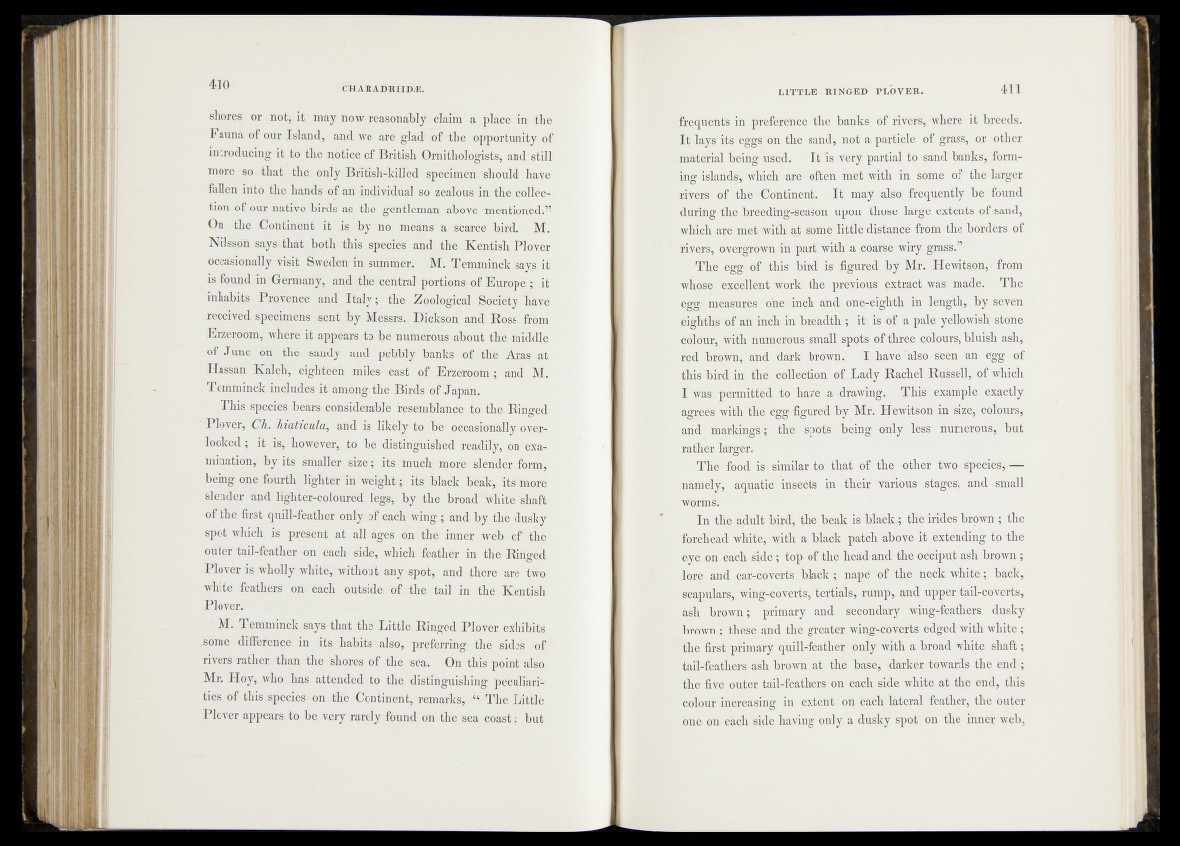
shores or hot, it may now reasonably claim a place in the
Fauna of our Island, and we are glad^of the opportunity of
introducing it to the notice of British OrnitK$|igis>t% and still
more-so—that the only British-killed specimerr^h-ould have
fallen into the hands of an -individual so zealous in the collec--
tion of our native birds as the gentlemajf above ihehtioned^"
On the -.Continent it is^ by no mean's a scarce, bird. M.
Nilsson says that .both this species and the .Kentish Plover
occasionally visit Sweden in: summer. M. Temniinck-says.-itl
is found in Germany, and thes-eentral portions-OftEutope, j it
inhabits Provence -and Italy; the ZoologicaLK^ciSy haye-
received specimens-sent by Messrs. Dickson and .Ro’s%;- from
Srzeroom, where it appears t o H numerous about- th ^ fe§S e~
of-June oh the .-sandy -ted pebbly, baffles ^©f the'- Aras jjflfe
Hassan' K lllflv eighteen" mife^easjT df?:E |ig tlm s .
Temminck includes-it among, the Birds of Japan-."
J ’Jiis species bears considerable resemblanqp&Q tSte Ringed
Plover, Ck. h ia ticu ia and is likely to b e ' occasionalll^^r-
dooked.; it is, however, to!- be distinguished rbadily, on e .^ ^
mination, b y its smaller size; it^fauch'-ntfO^/sl^^^^pform,.
being one-fourth lighter in weight;, fts7 bkclc beal4 . S m p r e
slender and lighkijCplonrecf - r ^ v /^ y -th eVJi hi=M shaft
of the first quill-feather only of e a ch ^M ^ ia rit| b vdhe dusky
spot which is present at alb ages: oh -th |^ p [ti% e 'b of - the
outer tail-feather on- each side',, whichhfeather ih ’-thOhRitfg.ed,
Plover is wholly white,;without any_spot, and there .aro^h#^
white- feathers onr pach outside^of th e . taibptf the-’ Kentish
Plover'. -1
— M. Temminck says that the Little_Ringed Plover e x h ib it
some difierence in A jh a b its , als<% prefemng-khe- iid e s eP
ntefei ra th e r than the sfiofes b f the'>$ea.;,* On this point also
Mr. Hoy* who has attended to the distinguishing peculiarities
of this-species on >the Contiheht, rem arksy £ 4 T-h(piittle
Plover appears to be very .rarely found on the sea coast-; but
frequents in preference the banks of rivers, where it breeds.
I t lays its eggs On the sand, not a particle of grass, or other
material being used. I t is very partial to sand banks, forming
islands,’which are often met with in some of the larger
rivers* the Continent. It may also frequently be found
duringHlfo;breeding-season upon those large extents of sand,
which are met with? at some little distance from the borders of
layer's, overgrown in part with a coarse wiry grass.”
The egg of"*this bird is figured by Mr. Hewitson, from
Whose-^excellent work the previous extract'was made. 1 The
l&g;1 mea^ufCbiVonu inch affd one^eighth in. length|ypy seven
teigltM^ofan mcBhn breadth ; it'-ps ’of a pale yellowish stone
Colour, with nuin-er«| small spots of three colours, bluish ash,
rfcd'.broviv and dark brown;1? I have'also seen- an egg of
in the Lady Rachel Russell, of which
-1 Was 'permittl!® to have a drawing. This example exactly
agrees vitbfcflie egg figiired-byrMr. Hewitson in size, colours,
and markmgS^th|t’ Spots’*' being only' les£ numerous, btlt
cratferla-r-ger.
The’'1^ * p i# s im ila r to^'ihat of t o o t h e r two’ species,—
g aM lf l aquaticfi^l©^ in their various 'stages, and small
In thp aduftl^dy^he beak» ® )la c k ; the hides brpwn ; the
forehead White', with' a! blhck'-patch above it Extending to the
|eye on each skfe; to p of the head and thdocciput ash-brown;
nape-’bf the' neck white; back,
scapulars, wing-coflks, tertials; rump, and upper tail-coverts,-
>ash. brown; primary' and' "shbotiS® wing-feathers dusky
, brown; t h & and the' greater wihg-Coverts edged with white;
Hhe first primary quill-feather only with a broad white shaft;
tail-feathefs ash brown, at the base, darker towards the en d ;
the fiy| outer ’tail-feathers- on each side white at the end, this
-^colour iifereasing in extent on each lateral feather, the outer
one on each side having only a dusky spot on the inner web,